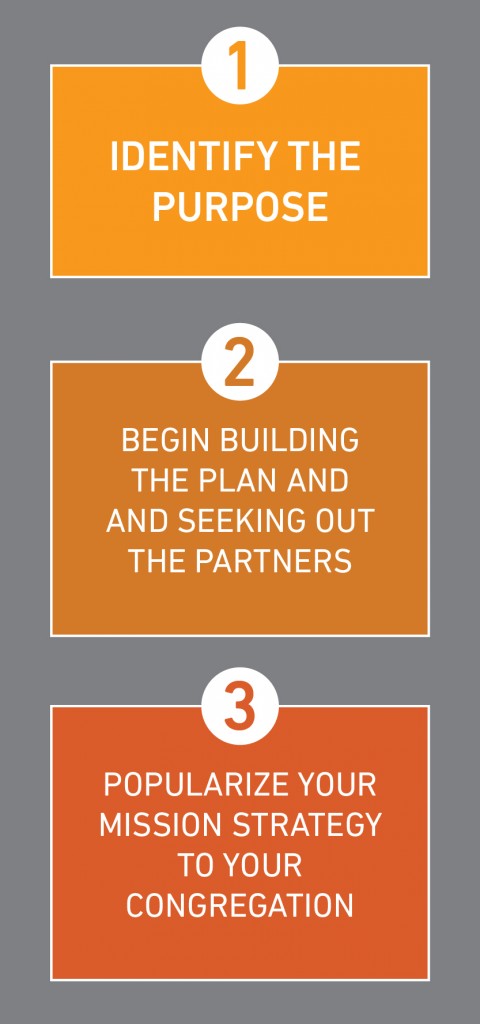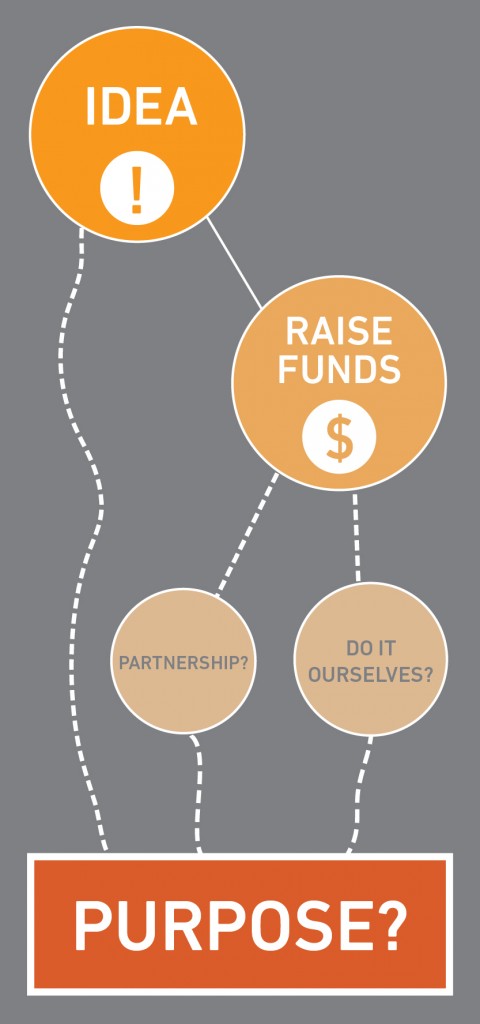You’ve done the hard work of getting down on paper your Purpose and asset mapped and begun to brainstorm the People you need to collaborate and partner with. Now it’s time to vision cast and Popularize the message to your body.
 The American Church has historically gotten people excited about missions first, then figured out the plan to carry it out. It used to be that churches would unveil an idea or a mission, then raise pledges or money to resource it. Once the support was in place, then they would move on to the next phase of identifying existing relationships—institutional or denominational—so they would know who their partners would be to carry out the idea. In many cases, they never got to a place where they actually had thought through and planned a purposeful program. The caveat with operating in this order is that many times if you start with popularization, you will never end up in that place of true purpose (and true outcome based ministry only leave this in if OBM is complete and there is something to link to).
The American Church has historically gotten people excited about missions first, then figured out the plan to carry it out. It used to be that churches would unveil an idea or a mission, then raise pledges or money to resource it. Once the support was in place, then they would move on to the next phase of identifying existing relationships—institutional or denominational—so they would know who their partners would be to carry out the idea. In many cases, they never got to a place where they actually had thought through and planned a purposeful program. The caveat with operating in this order is that many times if you start with popularization, you will never end up in that place of true purpose (and true outcome based ministry only leave this in if OBM is complete and there is something to link to).
We suggest this order instead.
 Why is Popularization important? Talking about why you do what you do is important. As you are sharing the vision, it naturally presents an authentic platform to allow you to teach missiological principles foundational to our faith and contextualize understanding of the body on the function of the Church.
Why is Popularization important? Talking about why you do what you do is important. As you are sharing the vision, it naturally presents an authentic platform to allow you to teach missiological principles foundational to our faith and contextualize understanding of the body on the function of the Church.
What does Popularization look like? Missions shouldn’t be a segregated “topic” that only gets discussed a weekend or two a year. Instead, it needs to be woven into every part of your programming and language. There are myriad ways to do that, including:
- A series on the purpose of your church’s missions program.
- Integrating your purpose message into all of your existing church communications.
- Clearly identifying and promoting the partners you will collaborate with.
- Regular teaching on missiology from elementary programming through adult small groups AND the pulpit.
- Clearly communicating a uniform message about your purpose, partners, and plan across all of your existing platforms such as: weekend services, kids church, youth/young adult gatherings, mid-week meetings, small groups, other regular gatherings, digital or physical spaces in your facilities. Plan to showcase your missions vision in several of these areas in order to keep it in front of your people.
A few pragmatic ways to invite people to participate in your missions strategy:
- Giving
- Prayer
- Teams
The first two on this list are self-explanatory, but I want to elaborate on two different types of missions teams to clear up on any misconceptions about this age-old concept.
1. Exposure teams—These teams are not being sent to fulfill the purpose of your mission, but to educate, inform and excite your people about the projects and initiatives you’re involved in. Many churches in America spend massive amounts of money sending their people to do missions overseas on teams like these where no outcomes are actually taking place. The majority of many missions programs are being cannibalized by exposure teams as opposed to specialized teams that contribute to an outcome.
2. Specialized teams— Specialized teams are highly effective at achieving specific outcomes. These teams are specially built from an outcome the collaborative partner has asked for and are going to the field to fulfill a specific purpose.
- Example: Seacoast Church was one of the pioneers in successfully conducting remote church locations using satellite video. An urban church in in a sensitive location had split into nine different groups. The urban pastor could not sustain traveling to nine congregations over a weekend. When he heard about what Seacoast was doing, we shared that model by sending over a specialized team comprised of experts in video, audio, and set up. Now those nine different congregations are able to receive the pastor’s teaching via video so the pastor only has to preach once but many different congregations can be blessed.
As we seek to be as informed and strategic as possible in building 21st century missions programs, we must be reflective of who God has made us to be, pursue the right partners and ensure we’re popularizing in an effective way so that our people clearly understand who God has made your church to be.
My prayer for you in this process:
Lord,
We come with humility before you to seek with everything that’s within us to be the best possible missionaries, every single one of us, every single one of us who have been called by Christ and have received the grace of God. Your mercy, your joy and your peace—you’ve given it to us for the purpose of giving it away to the world that you so desperately love. Help us make sure that we’re sharing you in the best possible way we can, understanding that as more is given, more is required. God, you have blessed us abundantly and now we want to use those resources as good stewards to be able to impact this world for you so that your hope your love can be made available to every person on the planet; in Jesus’ name, amen.
You should also read:
- Missions audit: 5 steps to evaluate the strength of your strategic vision
- 7 missions trends you need to know about RIGHT NOW!
- How to transition through the change well
- Tips to build a leadership dream team
- Outcome based ministry and why you need to do it



